
Cleaning Products: Homemade DIY Recipes & Uses
Cleaning Products: Homemade DIY Recipes & Uses: Whether you are looking for greener ways to clean your household or to make your own disinfectant, these tips will guide you to choose safe and healthy options. Forget purchasing expensive name brand cleaning supplies! Step away from chemicals that may be doing everyone more harm than good. Check out these homemade recipes for all your cleaning needs!
Following the increasing number of COVID-19 cases throughout the world, household cleaning and sanitizing has become a huge market. In fact, in some areas, it is almost impossible to find a can of Lysol or hand sanitizer in stock at most big box retailers. Worry not! Below we have compiled a comprehensive list of alternatives to purchasing name brand cleaning and disinfecting supplies. Not only will these be as effective at killing germs, but will last longer, be safer for the environment and most likely save you money!
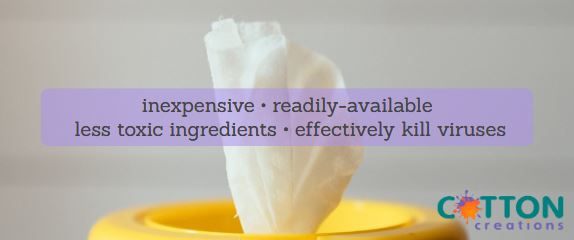
Make your own face mask with flour sack kitchen towels
100% cotton tea towels can be utilized as a substitute fabric for constructing a homemade face mask. While any cloth can help stop large droplets from getting in or out, be aware that fabric will not be perfect and only recommended for use as a last measure. According to a 2013 Cambridge study, dish towel material is 82 percent as effective as a surgical mask.
Avoid knit fabrics (e.g. jersey T-shirts) because the material stretches and creates holes. The best fabric for homemade masks is a tightly woven, 100% cotton fabric. It is recommended to pre-wash in hot water and high heat dry to allow shrinkage before constructing so the mask will keep its shape through multiple uses and washes.
According to GoodHouseKeeping.com, “on top of a sewing machine and fabric, you’ll need a nonwoven filter fabric to help block out particles and a metal piece (like a paper clip) to make it fit snugly around the nose.”
Two of the best sewing guides for cloth masks:
Printable free mask template by Amanda Perna, fashion designer and Project Runway alum.
Cloth face coverings should—
- fit snugly but comfortably against the side of the face
- be secured with ties or ear loops
- include multiple layers of fabric
- allow for breathing without restriction
- be able to be laundered and machine dried without damage or change to shape
CDC recommended DIY homemade cloth mask (with no-sew options)
Where do I buy flour sack towels?
Our selection of flour sack tea towels are perfect for homemade masks! With no minimum quantity, you can choose from a variety of sizes. We recommend our Premium towels with a 130 thread count as the best material for mask making. It is a breathable 100% cotton flat weave. Our Premium 20” x 20” size (folded in half) can make one mask. For bulk discount towels, add at least 12 or 50+ to your cart for an average savings of 30-60%!
Lists of places accepting donated fabric masks:
- list of health care facilities by The Sewing and Craft Alliance
- lists of hospitals by state by The U.C. Berkeley School of Public Health
********************************************************************************************
The MVP: Hydrogen peroxide
Hydrogen peroxide is not only a must have in your first aid kit but for reach under your kitchen and bathroom sink as well! Just like other oxygen-based bleaches, hydrogen peroxide breaks down safely into water and oxygen and is a more environmentally-friendly bleach than chlorine bleach (sodium hypochlorite). According to the CDC, hydrogen peroxide is effective at removing microorganisms, including bacteria, yeasts, fungi, viruses, and spores. “3% hydrogen peroxide, a stable and effective disinfectant when used on inanimate surfaces”

Everyday uses for Hydrogen peroxide:
- Use the bottle cap, that is on the bottle. Once a day, put one capful in your mouth and swish it around for 10 minutes, then spit it out. No more canker sores or gingivitis; and your teeth will be whiter and your breath will be fresher than with mouthwash.
- Soak your toothbrushes in a little peroxide to keep them germ free.
- It will kill the fungus and also any foot odor. If you have fungus on your feet spray a 50/50 mixture of peroxide and water on them (especially the toes) every night and let dry.
- Clean your counters and table tops with peroxide to kill germs and leave a fresh smell. Simply
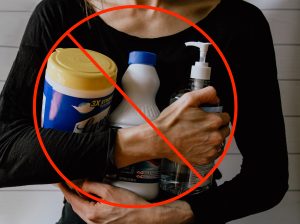 put a little on your dishrag when you wipe, or spray it on the counters.
put a little on your dishrag when you wipe, or spray it on the counters. - Put 8 ounces of peroxide in your bath to help rid boils, fungus, or other skin infections.
- Fill a spray bottle with a 50/50 mixture of peroxide and water and keep it in every bathroom to disinfect without harming your septic system like bleach or most other disinfectants will.
- Soak any infections or cuts in 3% peroxide for five to ten minutes several times a day. Gangrene that would not heal with any medicine, has been known to heal by soaking in peroxide.
- Tilt your head back and spray into nostrils, with your 50/50 mixture, whenever you have a cold or plugged-up sinuses. It will bubble and help to kill the bacteria. Hold in, for a few minutes, and then blow your nose into a tissue.
- After rinsing off your wooden cutting board, pour peroxide on it to kill salmonella and other bacteria.
- You can also add a cup of peroxide instead of bleach to a load of whites in your laundry to whiten them. If there is blood on clothing, pour it directly on the soiled spot. Let it sit for a minute, then rub it and rinse with cold water. Repeat if necessary.
Why you should NOT clean with bleach:
-
- Bleach can be dangerous for children
- Bleach interacts with other household chemicals
- Bleach has harmful effects on your body
- Cleaning with bleach can hurt your pets
- Bleach puts the environment at risk
- Alternatives to bleach can be just as effective
********************************************************************************************
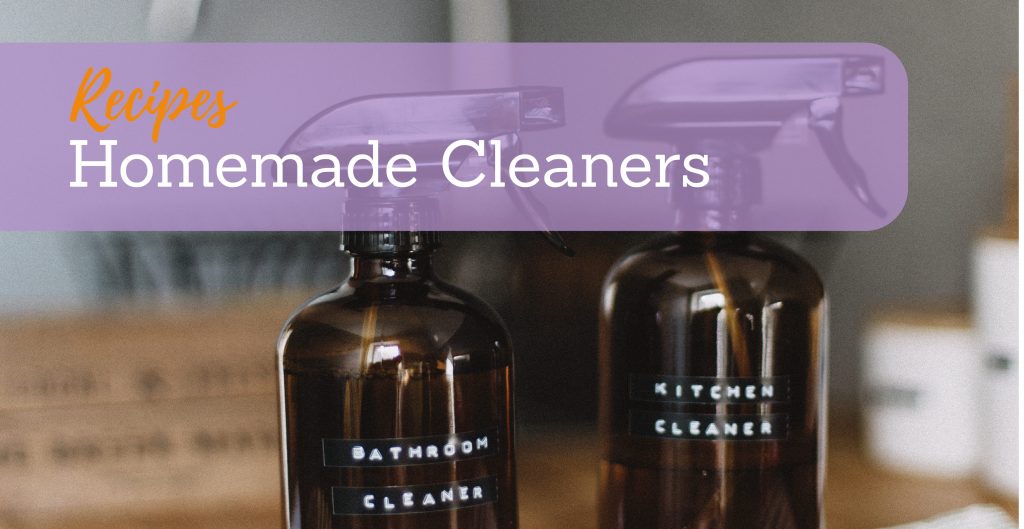
All-purpose Homemade Cleaners: Make your own antibacterial solutions!
- Vinegar solution
Mild: 1 tablespoon distilled white vinegar + 1 cup water
Strong: 1 cup distilled white vinegar + 1 cup water - Citric acid solution
Mild: 1 teaspoon citric acid powder + 1 cup water
Strong: 2 ½ teaspoons citric acid powder + 1 cup water - Dishwashing soap
Mild: ¾ teaspoon Sal Suds + 1 cup water + optional: a few drops tea tree oil
Strong: 2 teaspoons Sal Suds + 1 cup water + optional: 5-10 drops tea tree oil
Lysol Wipes DIY Dupe (no harsh chemicals):
- Cut in half a cheap roll of paper towels and set aside
- Mix together 1 cup water
- 2 tbsp of white vinegar
- ½ tbsp of dish soap
- 8-10 drops of essential oils
- Place paper towels in a tall plastic container and pour mixture over them. Remove the center cardboard (this is easier when it is already wet). Seal the lid on the container to lock in moisture.
- For use, pull the paper towels from the middle!
Some research has shown that certain viruses “can be efficiently inactivated by surface disinfection procedures with 62–71% ethanol, 0.5% hydrogen peroxide or 0.1% sodium hypochlorite within 1 minute.” Adding a little bit of water in your spray solution will increase its effectiveness.
Lysol Spray DIY Dupe (no harsh chemicals):
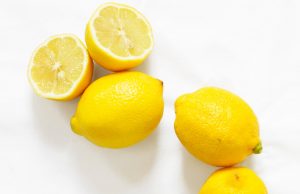
Using a 16oz spray bottle
- Pour 3 1/2 oz distilled water and
- 1/2 teaspoon hydrogen peroxide in the bottle.
- Drop in essential oils as desired (recommended below)
- 30 drops tea tree essential oil
- 15 drops lemon essential oil
- 15 drops lavender essential oil
- 15 drops eucalyptus essential oil
- Fill bottle with 12 oz of alcohol that is 140 proof or greater (70%+ alcohol) such as Everclear or rubbing alcohol
- Put on spray top and shake well to mix
- Don’t forget to label the bottle! Use to spray and wipe down on high-touch areas or anywhere you’d like to disinfect.
********************************************************************************************
when trusty soap & water are not available
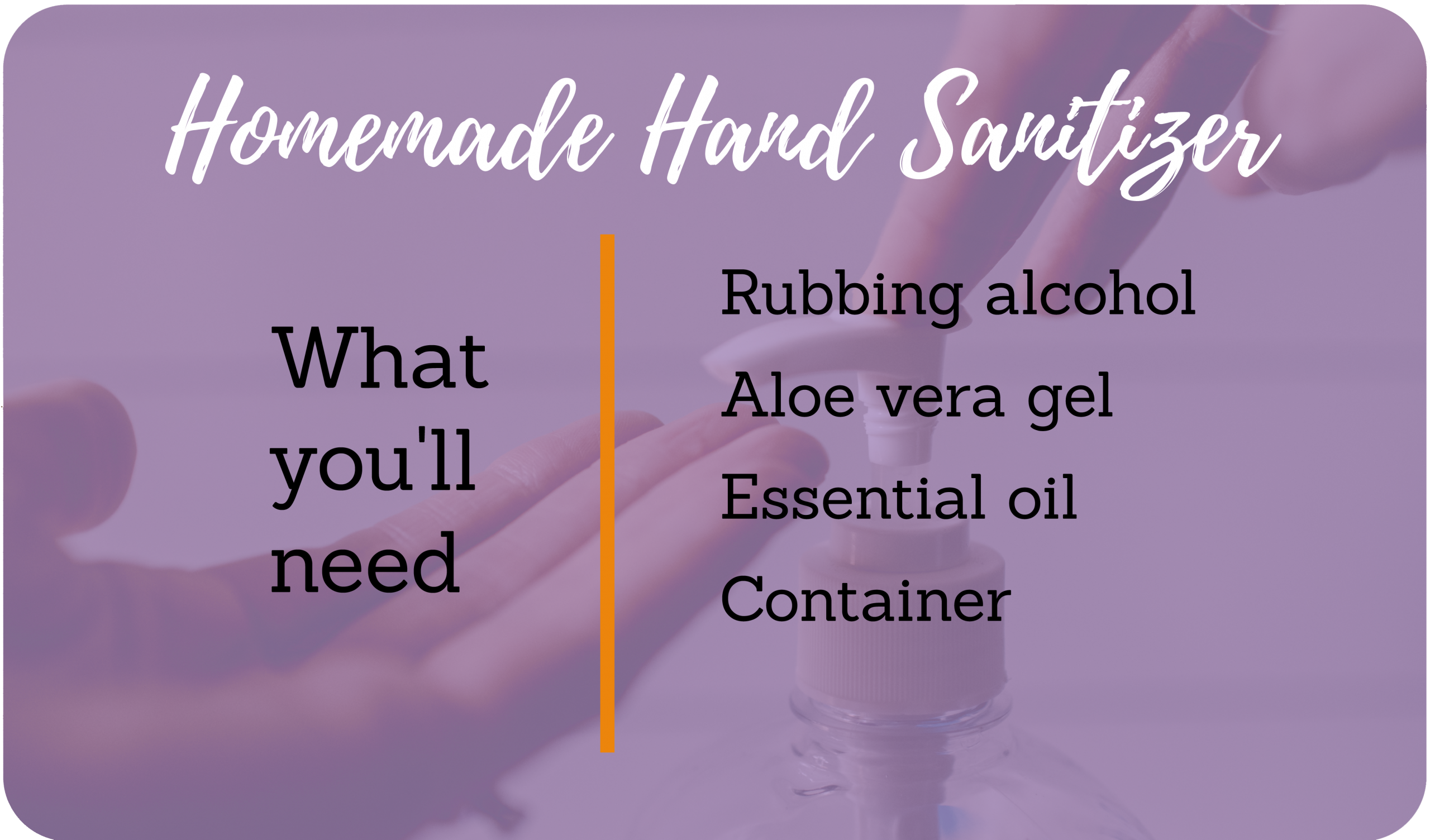
Make your own Hand Sanitizer!
* Hand sanitizers are only recommended to be used when you cannot use soap and water. Per the CDC, Hand sanitizer needs to contain at least 70% alcohol.
- 2/3 cups of rubbing alcohol (90% or higher recommended)
- 1/3 Aloe Vera gel (found in most grocery stores)
- Mix
- Add a few drops of an essential oil (only a couple of drops as to not dry out the skin.) Even better if you use an oil that contains antimicrobials properties!
- Use a funnel if necessary to add mixture into your container. Then, use away!

Essential Oils
Public Health and Human Services have recognized essential oils as safe substances and some essential oils contain compounds that can be used as antibacterial additives. It is important to do your research when purchasing essential oils, try to grab 100% pure, Food-grade, USDA-certified organic, GC-MS tested quality, cruelty-free, and ethically sourced if possible.
Essential oils that contain antimicrobials properties:
Tea Tree Oil: The oil possesses antibacterial, anti-inflammatory, antiviral, and antifungal properties.
Thyme (Thymol) Oil: The EPA lists Thymol as an agent for “Intermediate-level disinfection.” Thymol is a constituent of oil of thyme, a naturally occurring mixture of compounds in the thyme plant. Thymol is an active ingredient in products registered for use as animal repellents, fungicides/fungistats, medical disinfectants, tuberculocides, and virucides.
Eucalyptus Oil: Known for its invigorating, menthol-y smell, eucalyptus oil has cold-relieving and zen-inducing effects. It’s best used with a carrier oil or added to water in a diffuser or humidifier, although it can also be mixed with apple cider vinegar and dabbed on skin to treat insect bites or wounds.
Peppermint Oil: Peppermint is another versatile, antibacterial superstar and can be added to a homemade mouthwash or nail treatment.
Lemongrass Oil: Antibacterial lemongrass oil has many uses, ranging from a powerhouse skin toner to a natural floor cleaner.
Orange Oil: Orange oil is a smart choice for anyone looking for an uplifting-smelling antibacterial oil; plus, it has some great uses for skin care.
Bergamot Oil: Derived from the rinds of a citrus fruit, bergamot oil offers a soothing, zesty scent while also boasting antibacterial and anti-inflammatory properties. Due to its fresh fragrance, some like to mix it into a homemade deodorant or hand sanitizing gel, and it can also be used as a spot treatment for acne as long as it’s blended with a carrier oil first.
A few others honorable mentions: The essential oils of aegle, ageratum, citronella, geranium, palmarosa, and patchouli.
********************************************************************************************
Versatile items for cleaning:
- Distilled White Vinegar. Distilled white vinegar is both versatile and inexpensive, and it can be used as a nontoxic disinfecting agent. When US researchers tested commercial cleaning products against alternatives like vinegar and bicarbonate of soda, they discovered that neat vinegar killed a range of household pathogens. Science also tells us, for example, that vinegar will kill off the flu virus.
- Baking Soda. Baking soda itself is not a disinfectant, but it’s an effective cleanser when combined with other natural disinfectants like vinegar. To unclog a drain, pour a mixture of ½ cup of baking soda and ½ cup of vinegar into the drain. Leave it for 15 minutes, and pour hot water.
- Rubbing Alcohol, 70% Ethanol, Everclear. While any liquor can technically be used to sterilize wounds, high-proof grain alcohol is the most effective at killing bacteria. If you’re over the age of 21, consider purchasing a bottle to keep with your cleaning supplies (and out of reach of children, just like with the rest of your cleaning supplies).
- Citric acid. Lesser-known, but cleans exceedingly well and is a cost-effective agent of homemade cleaners. It is a weak acid from citrus fruits and is commonly used for preserving and flavoring food. An advantage over vinegar is that it has no smell. It comes as a form of crystalline powder, and you can buy it readily online such as Amazon. Citric Acid kills viruses, bacteria, fungi and TB. Have some lemon juice? Use them to add to your cleaning solution!
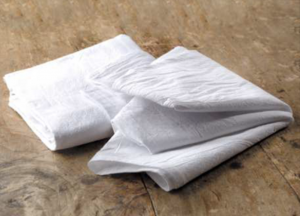
100% Cotton Flour Sack Towels - Cotton towels & rags. 100% cotton towels are reusable, lint free and great for quickly soaking up spills and messes. These are a must have around your kitchen, bathroom, garage and more! Use our unbleached natural flour sack towels for an environmentally friendly cleaning rag. The cotton is unbleached and is not treated with harsh chemicals. Use around food, sensitive skin, animals, plants, delicate surfaces and more. These towels have earned a long and proud reputation for being a trusted kitchen sidekick and environmentally conscious pick. Check out our blog post about types of towels.
- Microfiber Cleaning Cloths. Paper towels are a smaller financial investment up front, but the cost adds up quickly. Consider investing in one or two microfiber cleaning cloths, which can be washed and reused. Acts like a dirt magnet. Microfiber & water remove 99% of germs.
- Spray Bottles (16 oz). Cheap & easy to use on any surface. You can reuse these bottles indefinitely – just remember to keep refilling it with the same solution. You don’t want to accidentally mix a new solution with residue that was previously in the bottle and risk creating a toxic blend.
- Glass Containers. A glass spray bottle is the best storage container for homemade cleaners and essential oil recipes. Glass does not react with essential oils and other green cleaning ingredients. Dark glass storage bottles are best with hydrogen periodize mixes because Hydrogen peroxide is extremely light-sensitive.
********************************************************************************************
- Try microfiber mops and cloths, which can get rid of 99% of bacteria with plain water. Buy in bulk to save money.
- Make your own cleaners from common materials like baking soda, castille soap, or lemon juice.
- See consumer products on GoodGuide.
- Use disinfectants sparingly. The most important surfaces are doorknobs.
- Choose ready-to-use, peroxide- or citric acid-based disinfectants. Avoid disinfectants that list hypochlorites or quaternary ammonium compounds as ingredients (e.g., ammonium chloride).
- Small businesses can save money by switching to industrial/institutional cleaners. Ready-to-use products are 15 times more expensive than concentrates.
- Custodial companies that are SF Green Businesses should watch custodial green cleaning training videos in English, Cantonese, and Spanish and consider posting Custodial Green Cleaning Tips by SF Environment.
- Legally and safely dispose of cleaners (and other chemicals, electronics, lighting, metal, paints) in the U.S.
********************************************************************************************
Disinfection vs. Sterilization
Disinfection and sterilization are both decontamination processes. While disinfection is the process of eliminating or reducing harmful microorganisms from inanimate objects and surfaces, sterilization is the process of killing all microorganisms. That is the main difference between sterilizing and disinfecting. Sterilization also destroys the spores of various organisms present on surfaces, in liquids, in medication, or in compounds such as biological culture media. Such “extreme” forms of decontamination are needed during critical times like surgery, or in environments like industrial, laboratory or hospital. It is more practical to use disinfection in everyday life.
********************************************************************************************
References and Resources:
https://disinfectionandsterilization.org/
https://www.cdc.gov/infectioncontrol/guidelines/index.html/Disinfection_Nov_2008.pdf
Guideline for Disinfection and Sterilization in Healthcare Facilities CDC
https://www.moneycrashers.com/homemade-natural-cleaning-products-diy-recipes/
You Might Also Enjoy
- 6 Hacks for Spring Cleaning with Kids
- Tips For Washing Your Babies’ Onesies
- Tips For Cleaning and Maintaining Flour Sack Towels
SHARE THIS:


